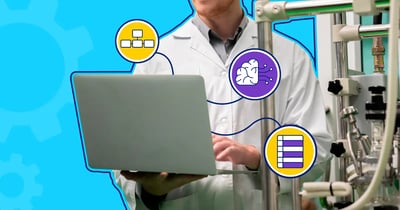During and after the COVID-19 pandemic, prevailing chaos in geopolitical and financial systems, sourcing materials, and maintaining the reliability of supply chains needed to sustain life has been increasingly difficult. Amidst this pandemonium, there are reasons to accelerate the technology-dominant revolution called “Industry 4.0,” but will this revolution solve intrinsically human problems? We live and work in socio-technical systems, and the maturity of our systems relates to the maturity of people and their technologies.
As a professional and a member of the life science sector, I am interested to understand how the maturity of socio-technical systems such as the pharmaceutical quality management system (pQMS) relates to what we measure, how we manage quality, and what tools to use. The industry needs to cope with the growing gap between technological advancements — i.e., a revolutionary rate compared to a standard evolutionary rate of developing pharmaceutical products and the maturity of professionals. Insights into some of these questions can be sought in the deliberations planned at the FDA’s Quality Management Maturity (QMM) Workshop.) From this context, this blog sets out to examine a series of life science lessons gleaned from the PAT to QbD journey — a journey in the 21st century our industry continues to traverse.
In 1987, regulatory guidance on the general principles of pharmaceutical process validation emphasized the notion that quality can not be tested into products; it needs to be built in by design. That’s where QbD – quality by design was initially derived while acknowledging that it is a more generally appreciated concept. Then in the year 2000, the first discussions on process analytical technology (PAT) were initiated. (PAT) focuses on reducing variability in processes by measuring, controlling, and modeling critical quality attributes to improve understanding. In 2011, the general principles of pharmaceutical process validation were updated to leverage process understanding and take a life-cycle approach to process development, qualification, and continuous process verification (CPV). Digitization of these data and information to achieve paperless validation facilitates real-time assurance of data integrity and the desired reduction in product variability. In 2022 the FDA is progressing its efforts on quality metrics and developing a program to review and grade manufacturer’s quality management maturity (QMM) in the drug product/active pharmaceutical space.
Throughout this journey, the sector experienced many ups and downs. These experiences offer opportunities to learn and re-learn why quality cannot simply be tested into products and must be included by design — by intent. These lessons have directly contributed to our industry arriving here, at this moment in 2022, with the current state of continuous manufacturing and the latest FDA efforts to facilitate the good (i.e., valid) maturity of systems, processes, and professionals in the pharmaceutical manufacturing space.
Lesson 1: Professional Development Is Essential
The opportunity for pharmaceutical professionals to glean life science lessons from the PAT to QbD journey starts with a consensus on qualification and continuous development of professionals. Reducing variable interpretation of the phrase “scientific training and experience,” introduced into the FD&C Act in 1962 by the Kefauver–Harris Amendment, to ensure decisions in the sector and quality management systems are made “fairly and responsibly” can help to inform how to evolve policies that facilitate good (i.e., valid) maturity of systems.
Professional development is translated in practices as suitability and capability to be fair and responsible at every job level (21 CFR § 211.25 – Personnel qualifications). Considering the principles of statistical process control (stability and capability) can offer ways to internalize these principles, facilitate learning, and emphasize the application of regulatory guidance documents more effectively. Taking a life-cycle approach to feedback and annual performance review aligned with “Annual Product Review” (21 CFR 211.180) should result in greater proactivity, error prevention, and resilience to better adapt to change even in chaotic conditions.
Lesson 2: Addressing Adult Human Development Empowers Our SMART Future
While it’s not obvious at first blush, there’s a distinct correlation between adult human development and our industry’s progress toward SMART manufacturing (self-monitoring analysis reporting technology). There are five [psychological] stages in adult human development (see also “In Over Our Heads,” by Robert Kegan):
- Impulse control
- Imperialist/control freaks
- Socialized mind
- Self-authored mind
- Self-transforming
The stage of the self-authored mind is our professional minimum. When we transcend the self-centered aspects of being self-authored, we can begin to think with a systems orientation and introduce empathy to our decision-making. This transformation directly impacts whether we can meet our SMART manufacturing objectives. (See why in lesson 3!)
The maturity aspects of our SMART manufacturing goals provide us with a basis to think about how we relate to them, given our current stage of [human] development. While practicing within and in the real world, self-monitoring, analysis, and reporting in real-time, we remain present and current in the revolution called “Pharma 4.0.” SMART objectives and SMART practices are how we can reach our personalized and patient-centric research, development, technology transfer, process validation, and CPV objectives.
Lesson 3: Education and Training Alone Cannot Overcome Displacement by AI
What is the current state of maturity of the system (a corporation, factory of QMS) – feeling in over our heads suggests laggard development. If so, why? Is it because the management and staff are lagging in professional development?
In reality, many in pharmaceutical manufacturing are already or soon will be competing with artificial intelligence for jobs. A maturity model (developed by BioPhorum) lays out the journey from the pre-digital plant to digital silos, to a connected plant, to a predictive plant, and finally to an adaptive plant. Step by step, it takes responsibility for routine activities away from humans and transfers that to automation and AI.
This new world is very different from where we worked in the past — and for many, separate from the expectations accustomed by our training and education. We need different skill sets to transition into the future. Scientific training and education are key components, but they alone are not enough. Professional development through experiential learning is necessary to empower our professional growth and maturity. For example, invest in new knowledge and maturing professionals and systems to facilitate good practices through team-wide experiential learning opportunities. The key takeaway is that professional development and maturity need to be synchronous with the SMART factory we work in and our city. This need for synchronization must be emphasized - this is the primary lesson I have learned in my PAT to QbD journey.
Maturity is the suitability and capability to make good (valid) decisions. Nothing is perfect, so maturity also relates to learning from and preventing errors across systems; reoccurring errors (i.e., mistakes) signal immaturity. We also use the notion of suitability (or stability) and capability to describe a process in the state of control, which “process validation” accomplishes. The implicit theme is “mind matters.” What we do to validate the manufacturing process (external) is also relevant to validating our thinking and decision-making processes (internal). Adopting SMART tools such as ValGenesis’ Validation Lifecycle Management System (VLMS) with SMART onboarding and training personnel on using it opens the opportunity to avoid mistakes and ensure data integrity and development. It opens the path to internal validation. With integrity, can we claim external validation without internal validation?
Experiential learning must run alongside technological development. Otherwise, we risk becoming subservient to technology. Our goal needs to be vigilant internal validation, keeping complex and chaotic influences at bay. That’s how we move from PAT standards to Pharma 4.0.
Lesson 4: Hone Quality Through Research
It’s our duty to ensure that our products are better than placebo. Experiential learning (see lesson 3) enables us to speak with One Voice of Quality, to be able to hear the voice of patients, and to fill the gaps between quality development and QMS effectiveness and the assurance of quality patient need — patient satisfaction.
Care is research. Research is defined broadly, not just laboratory research: thought experiments, process experiments, and other research we conduct to optimize quality. Knowledge is power; to do good, it needs wisdom in practice.
The life science lessons accumulated from the PAT to QbD journey remind us that good means valid, and the validity of scientific evidence is the foundation upon which Industry 4.0 revolution must progress to keep chaos at bay.



